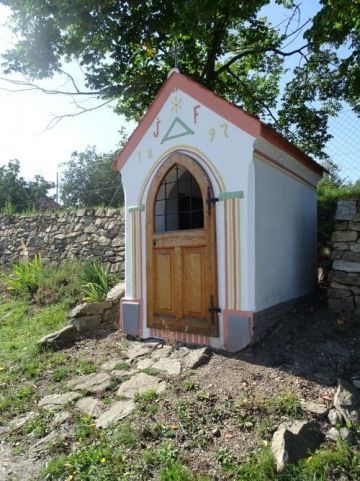Chapel and shrines
Sights worth seeing.

Chapel of the Saint John of Nepomuk
The Holasovice village chapel, dedicated to St. John of Nepomuk, is located in the northern part of the village square. It is one of the few small sacral buildings for which we know not only the time but also the circumstances of its creation. The authentic inscription about the foundation of the chapel has been preserved to this day - it is on a stone slab, walled in the back wall by the floor to the left of the altar mense.
The founders of the chapel were brothers Bartholomew and Joseph Pimiskorn, who were local natives. At the time of its foundation, the younger of the two, Josef, was a burgher in Prague's Nové Město, where he made his living as a beer merchant. The elder Bartoloměj entered the Cistercian monastery in Vyšší Brod in 1709 and after his ordination served as a priest in several parishes, including Strýčická, to which Holasovice belonged until 1784. Both brothers had the chapel built at their own expense, provided an altarpiece dedicated to the Holy Family and hung a small bell in the tower. However, it was a condition that it would be taken care of by the Holašovice municipality, which was confirmed on 31 October 1755 in a declaration signed by all the Holasovice farmers and witnessed by the Záboř bailiff and a teacher from Strýčice. This date and the initials of the donors are recorded on the altarpiece, together with a depiction of them.
How was the reconstruction of the Chapel of St. John of Nepomuk carried out?
The chapel is very interesting in its architectural design. Only the vault - a compressed vault with a pair of interlocking triangular sections - the only one of its kind in the village, corresponds to the time of its construction, i.e. after the middle of the 18th century. Other dateable structural elements on the building are baroque, but they were used in the village environment much later, in the first half of the 19th century. These include the indented rounded corners, the fabion cornice and, in particular, the gable style, which became a symbol of the rebuilding of the Holašovice farmsteads, but only around the mid-19th century. The plain design of the gable without a border and other decoration is also unusual. On the contrary, the connection of the building with the younger regional village building practices is indicated by the entrance portal, whose niche is turned the opposite way to the usual way, i.e. outwards. Such reversed entrances were used in village settings in situations where it was necessary to protect both the door and the person unlocking it from the weather. They were used as entrance gates to courtyards and especially as entrances to granaries.
In the square in front of the chapel there is a cross with a cast-iron body of Christ, consecrated in 1935. This cross is at least the third cross on this site, as evidenced by the entry from the memory book of the Čakov parish - it mentions the construction of a new wooden cross in 1879 to replace the older one.
Another cross can be found at the crossroads from the village square to Nová Ves. The memorial book of the Čakov parish records its erection in 1876 by Jakub Stropek, a farmer from farm No. 5, who undertook that the holders of this farm would take care of the cross and keep it in good condition forever. The cross with the body of Christ is made of cast iron, mounted in a slender square base of hewn granite, which is divided into a base, a stem and a cornice.
Chapels around the village
One of the two chapels in the vicinity of the village is located towards Záboří, on the northern edge. A written record of its creation is in the memorial book of the Čakov parish. It was built by the widow Marie Eiblová, the owner of the nearby homestead no. 22. The chapel was consecrated on 11 June 1876 in honour of Our Lady of Help. Nowadays there is another one, built by František Eibl, also from No. 22, in 1897. This small brick building with a gable roof contains an interior space enclosed by a vaulted vault. The surface of the gable is decorated with initials and dating. The most striking element of the decoration is the motifs of the canellated pilasters on the sides of the entrance. Today, these pilasters are highlighted with colour.
The second, small but distinctive chapel is located at the northeastern edge of the development, near house no. 46. No written record of its construction has survived, but a greater number of features link it to the period of significant rebuilding of the village in the second half of the 19th century. The square mass of the brick building is topped by a pitched roof rising to a gable with a Baroque outline, highlighted by a fablioned coping and underlined by a moulded cornice. The front wall is opened by a deeper segmentally enclosed niche, and similar shallow niches relieve the side walls. In the band between the gable and niche, the initials F.R and A.P are placed along with flower motifs, while the sides of the front niche are executed with stucco motifs of canellated pilasters with bizarre ionic capitals.
To the north of the village, along the old road to Záboří, there is a brick and plastered pillar-shaped devotional shrine, divided into a three-part plinth, a shaft and a head, topped by a flat tent canopy with a ceramic roof. The plinth is separated by a simple cornice motif, while the shaft is terminated by a more pronounced cornice, probably made of two preceding layers of bricks. There is a shallow rectangular recess for a picture in the upper part on the side facing the road. The manner of the upper cornice corresponds to the practice used on buildings at the turn of the 19th and 20th centuries. This plague column commemorates the epidemic that struck Holašovice in 1521, as well as the whole of southern Bohemia.
At the crossroads to the southwest of the village there is another cast-iron cross on a hewn granite base, which now protrudes only partly from the concrete plinth. The cross dates back to the end of the 19th century and it is possible that it is related to a report from the memory book of the Cakov parish, according to which it was erected in the fields behind the village in 1893 by Jan Mühlpek from the homestead No. 17.




















